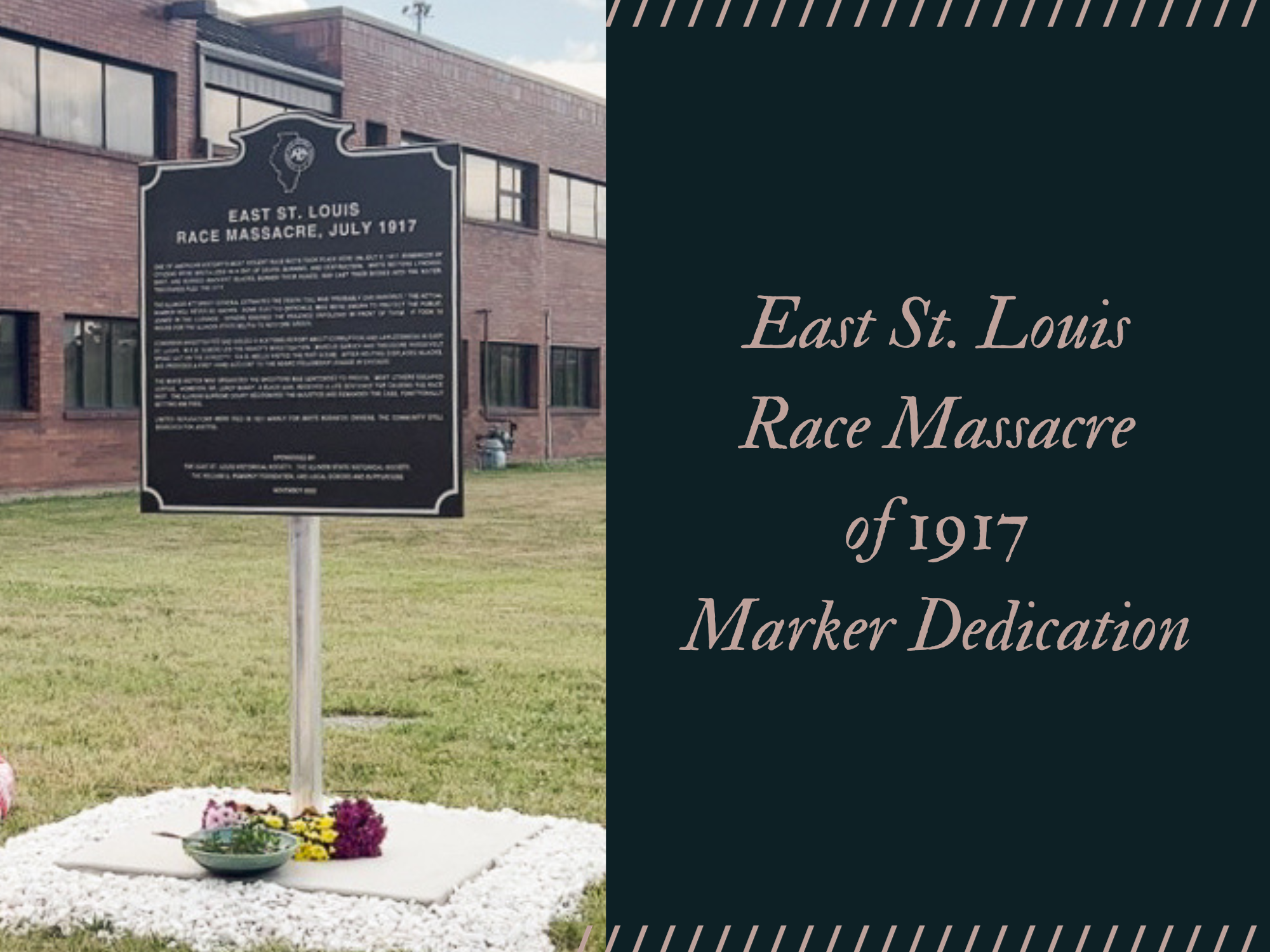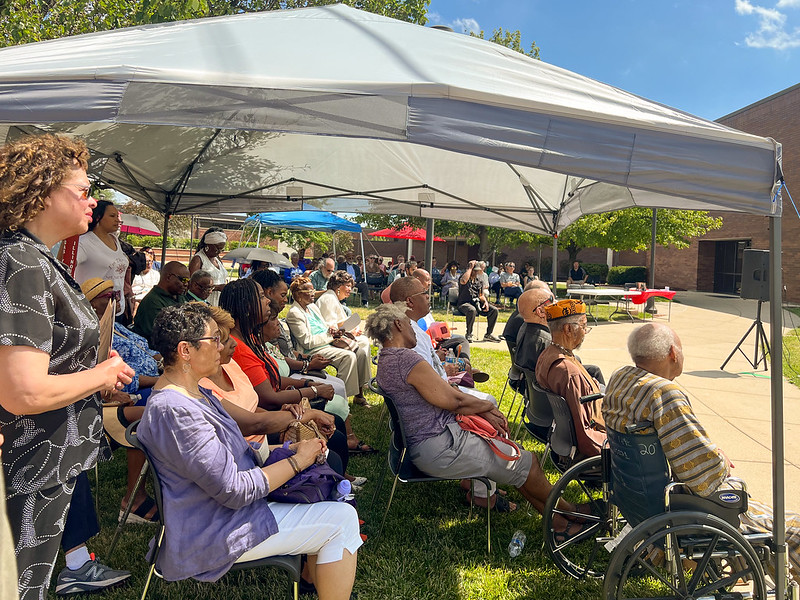By Jeannette Carrington
The East St. Louis Historical Society and the Illinois State Historical Society joined together to unveil a historical marker in remembrance of the 1917 East St. Louis Race Massacre. The commemoration ceremony was held on July 2, 2023, at the Wyvetter Younge Higher Education Campus of Southern Illinois University-Edwardsville, located at 601 James R. Thompson Boulevard in East St. Louis.
Guest speakers included Jaye Willis, Executive Director, E. St. Louis Historical Society; Hon. Charles Powell III, Mayor of E. St. Louis; and Rev. Joseph Brown, Co-Chairman of the 1917 Commission and Professor at SIUC.
The dedication was held on the 106th anniversary of one of American history’s most violent race massacres. This dark chapter in American history sheds light on the challenges faced by marginalized communities and reminds us of the ongoing fight for justice and equality.
Maori Brown, a 22-year-old content creator, and a forensic chemistry major, attended the marker dedication. “I pray that people visit it and reflect on what took place in the community. I want people to seek more information and share it with their friends and family. I want my generation to know history and decide what we believe from facts and not just how our family feels.” Miss Brown shared. “To learn from the past, you have to know the unbiased version of what happened. The truth. Often, we are lazy and don’t feel like finding and reading all the sources to find the truth. However, we need to. We need to actively strive for something better, not just say it.”
Charlie Moore, who also attended the marker dedication, hopes that anyone inside or outside of East St. Louis can realize how wrong the massacre was. He hopes that it helps to raise awareness about racial injustices and that people will come together as one more often. “I think it is important to have a historic marker dedicated to the 1917 East St. Louis Race Massacre because it is a part of African American history. I feel like African-American history does not get talked about enough. Therefore, people tend to forget about the tragedies, losses, and racism we had no choice but to live through. So, with most events that left a mark on America, this marker deserves to leave one on America too.”
Edmond Brown has lived near East St. Louis his entire life, although his family moved there in the early 1950s. They were not living in the area during the time of the massacre, as they resided in the border region of southern Illinois, Missouri, and Kentucky.
The East St. Louis Race Massacre happened during a time when racial tensions were high and economic disparities were prevalent. Many African Americans moved from the Southern states to the North in search of better job opportunities, especially due to the demands of World War I. However, this led to increased competition for jobs and housing, which caused resentment and division between different racial groups.
White workers at the Aluminum Ore Company went on strike, claiming that African Americans were taking their jobs. This strike sparked a series of violent events that lasted for several days and became known as the East St. Louis Race Massacre.
During the massacre, mobs of white residents, armed with weapons, roamed the streets, attacking African Americans without distinction. They targeted homes, businesses, and even streetcars, causing destruction and loss of life. The local authorities were overwhelmed and unable to control the violence, which resulted in the declaration of martial law and the deployment of the National Guard to restore order.
Mr. Brown believes that there hasn’t been real community awareness or understanding of the 1917 East St. Louis Race Massacre as there are other race riots that happened in this country. During his tenure in East St. Louis School District #189, this historical event of the city wasn’t a part of the school curriculum. “Historical events such as the ESL 1917 Race Riot should be required reading.” Mr. Brown exclaimed.
“I first became familiar with the 1917 East St. Louis Race Massacre (ESL 1917 Race Riot) during my freshman year in college at SIUE in 1971-72.” Mr. Brown said. “I purchased and read the book “Race Riot at East St. Louis – July 2, 1917” by Elliott M. Rudwick to learn more about the riot or the Pogrom of Black People.”
“In a time when Government officials of States such as Florida, Oklahoma, and Texas are trying to dismantle or remove history they don’t like, it is important that we preserve and study “all” history accurately. Black History is American History and should be taught in the same fashion as the other European Anglo-based historical events. I believe we first have to acknowledge the ugly past of this country, to atone if you will, before we can move on. I base this on the same analogy of an abusive relationship. If the abuser claims to have stopped being abusive and says, “Let’s just move on.” without a sincere apology or acknowledgment of their error behavior and that they have changed, it would be difficult for the relationship to move forward in a positive way.” Mr. Brown stated.
The dedication of this historic marker must have an impact on raising awareness about racial injustices and promoting unity. “Currently, there is an ongoing battle in our country, socially, economically, and politically, that root is based on race.
There appears to be a real fear by some as it relates to the changing demographic in this country as it is becoming more non-white. It appears that there is no room in this country for “parity”. I propose instead of looking at the opportunities in this country as limited and zero-sum gain, we explore the concept of value-added and growing the proverbial pie.”, continued Mr. Brown.
The consequences of the East St. Louis Race Massacre were devastating. It is estimated that between 40 and 200 African Americans lost their lives, while thousands were left homeless and displaced. The massacre exposed the deep-seated racism that was prevalent in society and emphasized the urgent need for equality and reform.
Mr. Brown continued, “One of the main ingredients that triggered the ESL 1917 Race Riot, was related to fear of African Americans coming from the South’s willingness to work jobs that White Anglos didn’t. Sounds familiar.”
In the massacre’s aftermath, investigations were conducted to understand the violence’s causes and effects. These investigations revealed systemic racism, housing discrimination, and economic inequality as contributing factors. The East St. Louis Race Massacre became a rallying point for the civil rights movement, inspiring efforts to combat these injustices and work towards a fairer society.
Mr. Brown said that the East St. Louis race riot of 1971 is just a symptom of an ongoing challenge this country has with race relationships. “The legacy of white flight, as well as black flight, throughout our urban corridors has left many communities without ample resources to maintain themselves. This occurrence is evident in what remains of East St. Louis.”
In 2015, Mr. Brown was appointed to the East St. Louis 1917 Centennial Commission and Cultural Initiative (https://estl1917ccci.us/), whose objective is to commemorate the 100th anniversary of this riot by hosting events to acknowledge and educate the citizens and people of the surrounding areas about this tragic event.
Mr. Brown points out that Spanish-American philosopher, poet, and novelist George Santayana once said, “Those who cannot remember the past are condemned to repeat it.” Mr. Brown said, “It is important that Americans, Black and White, know the unvarnished history of this country. The good, the bad and the ugly. The marker will act as a tombstone of sorts for those who were lost during this tragic event. It’s also a reminder that we must preserve history.”
As we commemorate the anniversary of this tragic event, it is essential to remember the victims and reflect on the lessons learned. The East St. Louis Race Massacre serves as a reminder of the progress made and the work that still lies ahead in the fight against racial injustice. It reminds us to stand united against hatred and division and to continue striving for a future where everyone is treated with dignity and equality.
“Not everyone in the community will understand the value of this plaque.,” Miss Brown said. “For history not to repeat itself something needs to be done for people to learn. Families are different. Some of our African American families pass stories down to teach the newest generation, other African American family members are so hurt by things that have happened that they can’t bring themselves to share what they have been through.,” shared Brown. “It’s better to be uncomfortable by things that have happened and educated than comfortable and ignorant.”
Mr. Brown proposes a federal historical park or mall in East St. Louis dedicated to the ESL 1917 race riots and similar events across the country. “The ESL 1917 Race Riot is just one sample of the tragic history of this country. What took place in East St. Louis happened in dozens of cities/communities throughout this country in one form or another. It is time for “We the People” to come to grips with our past and pledge to become a “More Perfect Union” that is built on the Christian Moral Standard we profess to be.”
Miss Brown shares, “This marker is a memorial of one moment in history. This isn’t just black history but everyone who lives, will live, or did live in this community. It is part of why the community is what it is today but with this understanding, a sturdy foundation can be built with God to prioritize and value each member of this community.”
We have the power to make a difference. By learning about and acknowledging the past, we can contribute to building a more inclusive and just society. Let us honor the memory of those affected by the East St. Louis Race Massacre by working together to promote understanding, respect, and equality for all.





